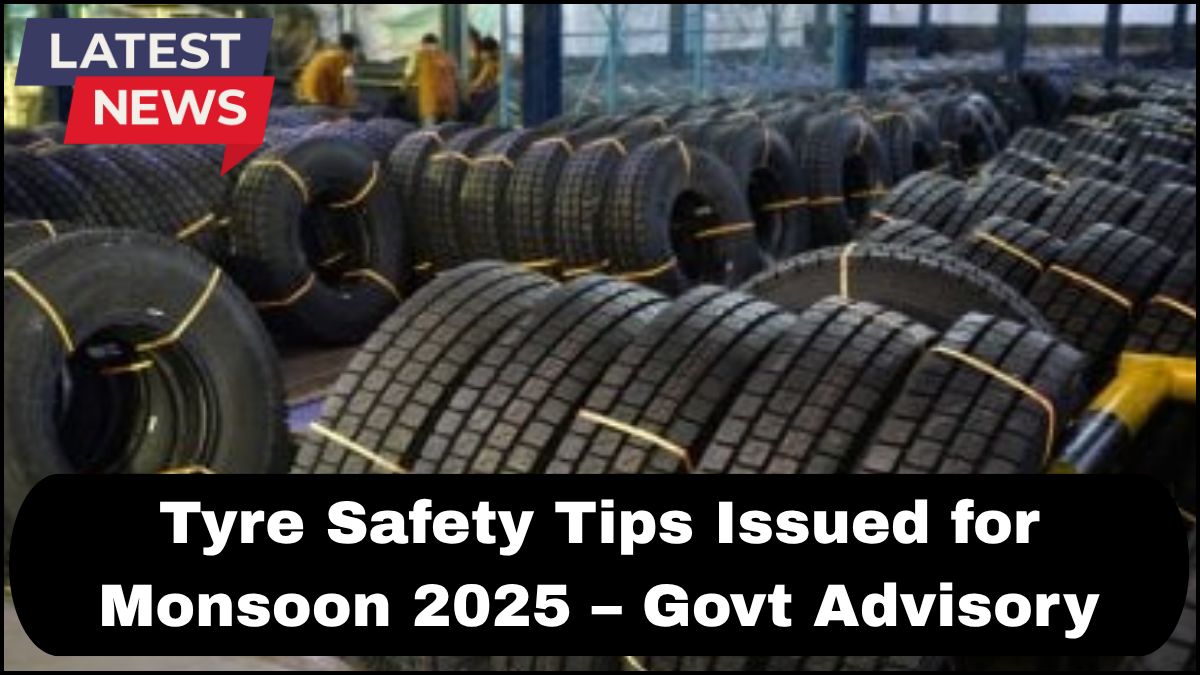As the monsoon season approaches, the Government of India has released a Govt advisory 2025 urging vehicle owners to prioritize tyre maintenance to ensure road safety. Heavy rainfall, slippery roads, and low visibility drastically increase the chances of road accidents during this season. The new Monsoon Tyre Safety Guidelines focus on proactive inspection, maintenance, and driving habits that can prevent tyre-related accidents and ensure safer mobility.

Here’s a detailed look at the tyre safety measures you need to follow this monsoon, as per the official advisory.
Inspect Tread Depth Regularly
Worn-out tyres are especially dangerous on wet roads. The Govt advisory 2025 mandates that tyre tread depth must not fall below 1.6 mm, though experts recommend replacing tyres once the tread goes below 2.5 mm in monsoon. Adequate tread helps channel water away from the contact patch, reducing the risk of hydroplaning.
Quick Tip: Use a one-rupee coin to check tread depth—if the coin’s rim is fully visible, it’s time to replace the tyre.
Ensure Proper Tyre Inflation
Tyre pressure fluctuates with temperature changes, which are common during monsoons. Under-inflated tyres reduce road grip, while over-inflated tyres increase the risk of skidding. Both conditions can compromise vehicle control on wet surfaces.
Pro Tip: Check tyre pressure every two weeks and especially after driving through waterlogged roads. Refer to the manufacturer’s recommended PSI, often found inside the driver’s door frame or the vehicle manual.
Rotate Tyres Periodically
Uneven tyre wear is a hidden hazard that compromises braking efficiency and cornering stability—critical issues during monsoon conditions. The Monsoon Tyre Safety Guidelines advise tyre rotation every 5,000 to 8,000 kilometers or during every major service cycle.
Rotating tyres ensures uniform tread wear, extending tyre life and maintaining consistent grip across all wheels.
Don’t Ignore Wheel Alignment and Balancing
Wheel alignment and balancing are often overlooked until there’s visible tyre wear or steering issues. However, during monsoon, poor alignment can cause a vehicle to drift unexpectedly on wet roads.
Warning Signs:
-
Uneven tread wear
-
Steering pulling to one side
-
Vibrations in the steering wheel
The Govt advisory 2025 recommends checking alignment during every service and especially before the monsoon begins.
Replace Old or Cracked Tyres
Ageing tyres lose elasticity, which reduces their ability to grip the road. Even if your tyres have sufficient tread, cracks or hardening rubber can lead to sudden failure, particularly on slippery roads.
If your tyres are more than 5 years old or show visible sidewall cracks, consider replacing them ahead of the monsoon.
Choose Tyres Designed for Wet Conditions
Some tyres are specifically engineered for wet grip, featuring deeper grooves and water-dispersing tread patterns. If you drive frequently during the rainy season or live in areas prone to flooding, consider switching to rain-performance tyres.
Example: Tyres with asymmetric tread or silica-rich compounds offer superior wet traction and braking.
Avoid Driving Through Deep Water
Driving through waterlogged roads can damage tyre sidewalls or dislodge the tyre from the rim, especially at higher speeds. If you must cross, do so slowly and steadily. After crossing, check for debris stuck in the tread and inspect for bulges or sidewall damage.
Maintain a Safe Driving Speed and Distance
Even with top-quality tyres, reckless driving can nullify safety. Wet roads require longer braking distances. Maintain at least double the usual distance between vehicles and reduce your speed to allow your tyres time to respond.
Key Points from the Govt Advisory 2025
-
Mandatory tread depth check before monsoon.
-
Strict recommendation against using retreaded tyres in wet conditions.
-
Promotion of certified tyre service centers for inspection and maintenance.
-
Awareness campaigns on Monsoon Tyre Safety Guidelines at toll booths and RTOs.
Frequently Asked Questions (FAQ)
Q1: How often should I check my tyres during the monsoon?
You should inspect your tyres every two weeks or after every long trip. Regular checks help identify early signs of wear or damage due to road debris or water exposure.
Q2: Can I use all-season tyres during monsoon?
Yes, but make sure they have sufficient tread depth and are not worn out. For better safety, rain-specific tyres or those with high wet grip ratings are preferable.
Q3: Is tyre pressure lower in monsoon due to cool temperatures?
Yes, cooler temperatures can slightly reduce tyre pressure. Always check pressure when tyres are cold and top up as needed to maintain optimal PSI.
Q4: Are tubeless tyres better for monsoon?
Tubeless tyres are generally safer as they deflate slowly when punctured, giving you better control. They’re also less likely to suffer blowouts compared to tube-type tyres.
Q5: Can water damage tyre rubber?
Repeated exposure to stagnant or chemically contaminated water can degrade rubber over time. It’s crucial to dry and inspect your tyres after driving through waterlogged areas.
click here to learn more